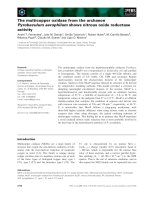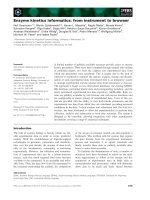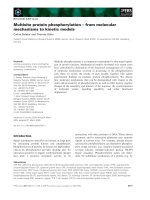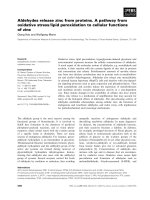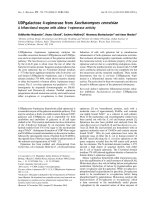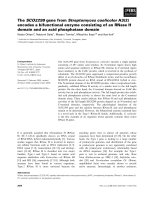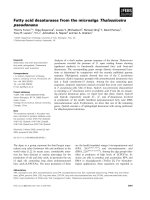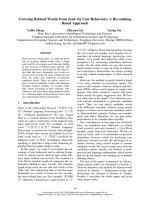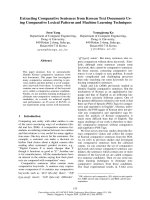Báo cáo khoa học: Purine nucleoside phosphorylases from hyperthermophilic Archaea require a CXC motif for stability and folding pot
Bạn đang xem bản rút gọn của tài liệu. Xem và tải ngay bản đầy đủ của tài liệu tại đây (560.31 KB, 7 trang )
Purine nucleoside phosphorylases from hyperthermophilic
Archaea require a CXC motif for stability and folding
Giovanna Cacciapuoti, Iolanda Peluso, Francesca Fuccio and Marina Porcelli
Department of Biochemistry and Biophysics ‘F. Cedrangolo’, Second University of Naples, Italy
Introduction
In the fascinating field of protein biochemistry, ther-
mostability and folding comprise important factors
that are currently gaining wide attention. Disulfide
bonds represent an important structural feature of
many proteins, especially extracellular ones. They not
only stabilize protein structures by lowering the
entropy of the unfolded polypeptide, but also are
required for the proper folding and biological activity
of several proteins. Disulfide bond formation occurs in
the endoplasmic reticulum and mitochondrial inter-
membrane space of eukaryotes and in the periplasm of
prokaryotes [1]. Disulfide bonds are a typical feature
of secretory proteins and are considered to contribute
significantly to their overall stability [2]. By contrast,
in intracellular proteins from well-known organisms,
and as a result of the reductive chemical environment
inside the cells [3], the presence of these covalent links
is limited to proteins involved in the mechanism of
the response to redox stress [4] or to proteins catalyz-
ing oxidation–reduction processes [1,5]. Despite this
classical view, recent computational, structural and
biochemical studies have highlighted the critical role of
Keywords
5¢-deoxy-5¢-methylthioadenosine
phosphorylase; CXC motif and oxidative
protein folding; disulfide bonds;
hyperthermophilic proteins; purine
nucleoside phosphorylase
Correspondence
G. Cacciapuoti, Dipartimento di Biochimica e
Biofisica ‘F. Cedrangolo’, Seconda Universita
`
di Napoli, Via Costantinopoli 16,
80138 Napoli, Italy
Fax: +39 081 5667519
Tel: +39 081 5667519
E-mail:
(Received 5 June 2009, revised 22 July
2009, accepted 29 July 2009)
doi:10.1111/j.1742-4658.2009.07247.x
5¢-Deoxy-5¢-methylthioadenosine phosphorylase II from Sulfolobus solfatari-
cus (SsMTAPII) and purine nucleoside phosphorylase from Pyrococcus
furiosus (PfPNP) are hyperthermophilic purine nucleoside phosphorylases
stabilized by intrasubunit disulfide bonds. In their C-terminus, both
enzymes harbour a CXC motif analogous to the CXXC motif present at
the active site of eukaryotic protein disulfide isomerase. By monitoring the
refolding of SsMTAPII, PfPNP and their mutants lacking the C-terminal
cysteine pair after guanidine-induced unfolding, we demonstrated that the
CXC motif is required for the folding of these enzymes. Moreover, two
synthesized CXC-containing peptides with the same amino acid sequences
present in the C-terminal regions of SsMTAPII and PfPNP were found to
act as in vitro catalysts of oxidative folding. These small peptides are
involved in the folding of partially refolded SsMTAPII, PfPNP and their
CXC-lacking mutants, with a concomitant recovery of their catalytic activ-
ity, thus indicating that the CXC motif is necessary to obtain complete
reversibility from the unfolded state of the two proteins. The two CXC-
containing peptides are also able to reactivate scrambled RNaseA. The
data obtained in the present study represent the first example of how the
CXC motif improves both stability and folding in hyperthermophilic
proteins with disulfide bonds.
Abbreviations
AdoMet, S-adenosylmethionine; GdnCl, guanidinium chloride; GSH, glutathione; GSSG, glutathione disulfide; MTA, 5¢-deoxy-5¢-
methylthioadenosine; MTAP, 5¢-deoxy-5¢-methylthioadenosine phosphorylase; PDI, protein disulfide isomerase; PfCGC, NH
2
-RRCGCKD-
COOH; PfPNP, purine nucleoside phosphorylase from Pyrococcus furiosus; PNP, purine nucleoside phosphorylase; sRNaseA, scrambled
RNaseA; SsCSC, NH
2
-GSCSCCN-COOH; SsMTAPII, 5¢-deoxy-5¢-methylthioadenosine phosphorylase II from Sulfolobus solfataricus.
FEBS Journal 276 (2009) 5799–5805 ª 2009 The Authors Journal compilation ª 2009 FEBS 5799
these covalent links in the structural stabilization of
intracellular proteins in some hyperthermophilic
Archaea and Bacteria [6–12].
The abundance of disulfides observed across hyper-
thermophilic organisms also has stimulated research
into the identification of the biochemical mechanisms
related to disulfide maintenance. It was recently dem-
onstrated that specific protein disulfide oxidoreducta-
ses, which are structurally and functionally related to
protein disulfide isomerase (PDI) [13], play a key role
in intracellular disulfide shuffling in hyperthermophilic
proteins [14].
Two enzymes, 5¢-deoxy-5¢-methylthioadenosine pho-
sphorylase II from Sulfolobus solfataricus (SsMTAPII)
[10,11] and purine nucleoside phosphorylase from
Pyrococccus furiosus (PfPNP) [12], have been isolated
and characterized from hyperthermophilic Archaea.
These enzymes are members of purine nucleoside phos-
phorylases (PNP), comprising ubiquitous enzymes of
purine metabolism that function in the salvage path-
way of the cells [15]. SsMTAPII is a homohexamer
(subunit 30 kDa) characterized by extremely high
affinity towards 5¢-deoxy-5¢-methylthioadenosine
(MTA), a natural sulfur-containing nucleoside formed
by S-adenosylmethionine (AdoMet) mainly through
polyamine biosynthesis [16]. SsMTAPII shares 51%
identity with human 5¢-deoxy-5¢-methylthioadenosine
phosphorylase (MTAP) and is able to recognize adeno-
sine [10], in contrast to human MTAP which is strictly
specific for MTA [17]. PfPNP displays a much higher
similarity with MTAP than with PNP family members
[12]. Similar to human PNP [18], PfPNP shows an
absolute specificity for inosine and guanosine [12].
SsMTAPII and PfPNP show features of exceptional
thermophilicity and thermostability and are character-
ized by stabilizing disulfide bonds. Two pairs of intra-
subunit disulfide bridges have been revealed by the
crystal structure of SsMTAPII [11] and three pairs of
intrasubunit disulfide bridges have been assigned to
PfPNP by integrating biochemical methodologies with
MS [12].
It is interesting to note that SsMTAPII and PfPNP
contain, in their C-terminal region, an unusual CXC
motif (i.e. cysteines separated by one neighbouring
amino acid X) as a typical feature, and that the substi-
tution of these two cysteines with serines significantly
affects both their thermodynamic and kinetic stability
[10,12], suggesting the involvement of the cysteine pair
in the thermal stabilization of both enzymes.
In the present study, we demonstrate that the CXC
motif of SsMTAPII and PfPNP plays an important
functional role in the oxidative folding of these
enzymes and that two short CXC-containing peptides
with amino acid sequences corresponding to those
present in the C-terminal region of SsMTAPII and
PfPNP, respectively, act in vitro as functional mimics
of PDI. The presence of a CXC motif in hyperthermo-
philic proteins with multiple disulfide bonds, such as
SsMTAPII and PfPNP, represents the first example of
a new molecular strategy adopted by these enzymes to
improve their stability and to preserve their folded
state under extreme conditions.
Results and Discussion
SsMTAPII and PfPNP require a CXC motif to
preserve their folded state
SsMTAPII and PfPNP are highly thermoactive, with
an optimum temperature of 120 °C, and extremely
thermostable, with apparent T
m
values of 112 °C and
110 °C, respectively. These enzymes are also character-
ized by a remarkable kinetic stability and resistance to
many chemicals, including SDS and guanidinium chlo-
ride (GdnCl) [10,12]. As demonstrated by structural
and biochemical studies, SsMTAPII and PfPNP utilize
multiple intrasubunit disulfide bridges as a principal
mechanism to achieve superior levels of stability
[11,12]. A striking structural feature of these two
enzymes is the presence in their C-terminal region of a
cysteine pair, organized in an unusual CXC sequence
motif. This structural motif plays an important role in
thermal stability because the substitution of cysteine
with serine results in a significant lowering of the
thermodynamic and kinetic stability parameters of
SsMTAPII and PfPNP [10,12]. The stabilizing role of
the CXC disulfide appears almost intriguing. Indeed,
disulfide bonds are expected to make a higher contri-
bution to thermostability when they join residues far
apart in the primary structure. Instead, in SsMTAPII
and PfPNP, they are separated by a single residue of
small size (i.e. serine and glycine, respectively).
Therefore, the stability imparted to the native protein
structure could be almost marginal. On the basis of
these observations, it is possible to hypothesize that
CXC plays an important functional role in stabilizing
the protein through an oxidative folding mechanism
involving the other structural disulfides of the enzyme.
Although rare in nature, few examples of oxidized
CXC have been reported in the literature, including
CSC in the Mengo virus coat protein [19], CSC in the
L40C mutant of NADH peroxidase [20], CDC in AK1
protease from Bacillus sp. [21], CTC in chaperone
Hsp33 from Escherichia coli [22], CPC in redox-regu-
lated import receptor Mia40 [23,24] and CGC in
MTAP from P. furiosus [9], which is highly homo-
CXC and oxidative protein folding G. Cacciapuoti et al.
5800 FEBS Journal 276 (2009) 5799–5805 ª 2009 The Authors Journal compilation ª 2009 FEBS
logous to SsMTAPII and PfPNP. It is interesting to
note that a CGC motif at the C-terminus of the yeast
thiol oxidase Erv2p was found to be involved in the
exchange of the de novo synthesized disulfide bridge
with substrate protein [25]. Moreover, it was demon-
strated that a synthesized CGC peptide and a CGC
motif in a mutant of E. coli thioredoxin were func-
tional mimics of PDI [26]. Taken together, these data
allowed us to speculate that the CXC motif in SsM-
TAPII and PfPNP could act as a redox reagent and
exert its stabilizing role by rescuing, in analogy with
PDI, any possible damage of the other disulfide bonds
of the protein. To demonstrate the active role of CXC
motif in the oxidative folding process, we carried out
the unfolding of SsMTAPII, PfPNP and their CXC-
lacking mutants by incubation for 22 h at 25 °C with
6 m GdnCl in 20 mm Tris ⁄ HCl (pH 7.4), containing
30 mm dithiothreitol. The reversibility of the GdnCl-
induced unfolding was then examined by assaying
the catalytic activity after complete removal of the
denaturant.
As shown in Fig. 1, SsMTAPII and PfPNP are able
to refold with a recovery of catalytic activity of 59%
and 90%, respectively, compared to their control
enzymes. By contrast, lower values of reactivation were
observed for SsMTAPIIC259S ⁄ C261S and PfPNPC
254S ⁄ C256S, the two CXC-lacking mutants (25% and
46% activity, respectively). These results demonstrate
that the CXC motif is necessary to obtain almost com-
plete reversibility from the unfolded state, and suggest
that the cysteine pair is able to act as redox reagent in
the rearrangement of scrambled disulfide bonds, thus
contributing to the recovery of native and biologically
active enzyme. The observation that, in analogy with
Erv2p [25], the CXC motif is part of a flexible C-termi-
nal segment in SsMTAPII and in PfPNP [10,12], and
that the CXC motif is very close to the two pairs of
disulfide bridges in SsMTAPII [11], further strengthens
this hypothesis.
The data obtained in the present study represent the
first example of how the CXC motif improves stability
and folding in hyperthermophilic disulfide-containing
proteins and could provide useful information with
respect to engineering stable proteins and enzymes for
therapeutic and industrial applications.
From the sequence comparison of the C-terminal
region of several PNPs present in databases, it appears
that, despite their remarkable amino acid sequence
identity, the CXC motif is conserved only in hyper-
thermophilic enzymes, whereas it is absent in their
mesophilic counterparts (Fig. 2). This observation
suggests a specific role of this structural motif in the
stability of hyperthermophilic PNPs against extreme
temperature and allows the hypothesis that the CXC
disulfide could represent an additional aspect (i.e.
besides protein disulfide oxidoreductase protein) of the
complex system involved in disulfide bond mainte-
nance in hyperthermophilic organisms.
NH
2
-GSCSCCN-COOH (SsCSC) and
NH
2
-RRCGCKD-COOH (PfCGC) act as in vitro
catalysts of oxidative protein folding
PDI, the most efficient known catalyst of oxidative
folding, is a multifunctional eukaryotic enzyme that
utilizes the active site motif CGHC to catalyze the for-
mation of native disulfides and the rearrangement of
incorrect disulfide bonds, especially those within kineti-
cally trapped, structured folding intermediates [13]. In
recent years, interest in protein folding in vitro has
expanded rapidly, mainly focusing on the production,
in bacteria, of disulfide-containing proteins with poten-
tial biotechnological applications. Therefore, increased
attention has been paid to the design and synthesis of
novel, small-molecule reagents that could improve the
efficiency of the oxidative folding process. Recently, on
the basis of the physical properties of PDI, a variety
of CXXC peptides have been synthesized and assayed
[27]. The active site of PDI has also been modeled as a
SsMTAPII
SsMTAPII C259S/C261S
PfPNP
PfPNP C254S/C256S
100
60
80
SsMTAPII
C259S/C261S
PfPNP C254S/C256S
0
20
40
Relative activity (%)
Fig. 1. Refolding of SsMTAPII, PfPNP and their CXC-lacking
mutants after Gdn-induced unfolding. The reversibility of Gdn-
induced unfolding of MTAPII, PfPNP and their respective mutants
was started by a 20-fold dilution of the unfolding mixture and
extensive dialysis until complete removal of GdnCl. Refolding was
analyzed by catalytic activity measurements performed under stan-
dard conditions. U ⁄ R indicates SsMTAPII, PfPNP and their mutants
refolded after GdnCl-induced unfolding. The activity of control
enzymes was expressed as 100%. Each value is the average of
three separate experiments.
G. Cacciapuoti et al. CXC and oxidative protein folding
FEBS Journal 276 (2009) 5799–5805 ª 2009 The Authors Journal compilation ª 2009 FEBS 5801
CGC peptide, a molecule that, upon oxidation, forms
a strained 11-membered disulfide ring, representing a
good oxidizing agent [26]. This peptide shows a disul-
fide reduction potential close to that of PDI and its
first thiol pK
a
is less than that of the natural redox
reagent glutathione. Therefore, this CXC peptide is
able to function as an efficient catalyst of disulfide
isomerization [26]. On the basis of these observations,
and in analogy with PDI, it is possible to hypothesize
a nucleophilic attack of the thiolate from CXC on an
incorrect protein disulfide followed by a thiol–disulfide
interchange within the substrate, leading in turn to a
native disulfide. Two CXC-containing peptides, namely
SsCSC and PfCGC, whose amino acid sequences are
identical to those present in the C-terminal region of
SsMTAPII and PfPNP, respectively, have been synthe-
sized and their disulfide isomerase activity has been
assayed utilizing the partially refolded forms of
SsMTAPII, PfPNP and their CXC-lacking mutants as
substrates. As shown in Fig. 3, both peptides are
involved in the oxidative folding of these enzymes with
a concomitant recovery of their catalytic activity.
Indeed, after 22 h of incubation in the presence of
SsCSC and PfCGC, the enzymatic activity of
SsMTAPII and its mutant, expressed as a percentage
of their control enzymes, reaches 86.8% and 51.8%,
and 68% and 49.3%, respectively (Fig. 3A). Similar
results were obtained when the unfolded ⁄ refolded
forms of PfPNP and its mutant were assayed under
the same experimental conditions (Fig. 3B). It is inter-
esting to note that, although PfPNP and its mutant
show a higher reactivation values than SsMTAPII and
its mutant (Fig. 3), the ratio of these values with
respect of their control enzymes is similar, thus indicat-
ing that the efficiency of the process is comparable.
These data demonstrate that the CXC motif of SsM-
TAPII and PfPNP is active, even when isolated from
the proteins, and that it is able to induce the in vitro
oxidative folding of these enzymes.
To further confirm the ability of SsCSC and PfCGC
to function as efficient catalysts of oxidative protein
folding, the disulfide isomerase activity of these CXC-
containing peptides was assayed by monitoring the
reactivation of scrambled RNaseA (sRNaseA). As
shown in Fig. 4, after 210 min of incubation in the
presence of SsCSC and PfCGC, inactive sRNaseA
shows a 5.5-fold and 3.6-fold activation, respectively,
compared to the 8.9-fold activation observed in the
presence of PDI. These results demonstrate that the
two CXC-containing peptides can act in the same way
Fig. 2. Multiple sequence alignment of C-terminal regions of hyperthermophilic and mesophilic PNPs. The CXC motif is shown in white
lettering on a black background.
100
AB
SsMTAPII
SsMTAPII C259S/C261S
PfPNP
PfPNP C254S/C256S
20
40
60
80
0
U|R
U/R + PDI
U/R + SsCSC
U/R + PfCGC
U|R
U/R + PDI
U/R + SsCS
C
U/R + PfCGC
Relative activity (%)
Fig. 3. Effect of CXC-containing peptides on
the reactivation of refolded SsMTAPII,
PfPNP and their mutants. SsMTAPII, PfPNP
and their mutants, partially refolded after
GdnCl-induced unfolding, (U ⁄ R), were incu-
bated for 22 h at 30 °C in the presence of
various oxidative folding catalysts (reactiva-
tion assay). The catalytic activity of (A) SsM-
TAPII and SsMTAPIIC259S ⁄ C261S and (B)
PfPNP and PfPNPC254S ⁄ C256S was then
measured under standard assay conditions.
The activity of control enzymes was
expressed as 100%. Each value is the
average of three separate experiments.
CXC and oxidative protein folding G. Cacciapuoti et al.
5802 FEBS Journal 276 (2009) 5799–5805 ª 2009 The Authors Journal compilation ª 2009 FEBS
as PDI, catalyzing the rearrangement of incorrect
disulfide bonds in a protein substrate. It is interesting
to note that SsCSC displays a higher oxidative folding
activity than PfCGC (Figs 3 and 4), suggesting that
the presence in SsCSC of a third thiol in the sequence
CXCC could most likely enhance the reactivity toward
disulfide bonds.
In conclusion, the results obtained in the present
study provide insight into the variety of molecular
mechanisms utilized for stabilizing folded proteins under
extreme thermal environments and allow us to speculate
that disulfide bonds and the CXC motif could combine
together to provide a novel stabilization strategy.
Experimental procedures
Materials
Glutathione disulfide (GSSG), glutathione (GSH), bovine
liver PDI and bovine pancreatic sRNaseA were obtained
from Sigma. GdnCl and dithiothreitol were obtained from
Applichem (Darmstadt, Germany). [methyl-
14
C]AdoMet
(50–60 mCiÆmmol
)1
was supplied by the Radiochemical
Centre (Amersham Bioscience, Little Chalfont, UK). MTA
and 5¢-[methyl-
14
C]MTA were prepared from unlabeled and
labeled AdoMet [10]. Specifically synthesized CXC-contain-
ing peptides, PfCGC and SsCSC, were obtained from
PRIMM (Milan, Italy). All reagents were of the purest
commercial grade.
Expression and purification of SsMTAPII, PfPNP
and their mutant forms
SsMTAPII, PfPNP and their CXC-lacking mutants (i.e.
SsMTAPIIC259S ⁄ C261S and PfPNPC254S ⁄ C256S) utilized
for these studies were expressed and purified as previously
described [10,12]. Manipulations of DNA and E. coli
were carried out using standard protocols [10,12,28].
Protein concentration was determined by the Bradford
assay [29].
Assays of enzyme activity
PNP activity was determined by monitoring the formation
of purine base from the corresponding nucleoside by HPLC
using a Beckman System Gold apparatus (Beckman Coul-
ter, Fullerton, CA, USA). The assay was carried out as
described previously [12].
MTAP activity was determined by monitoring the forma-
tion of [methyl-
14
C]5-methylthioribose-1-phosphate from
5¢-[methyl-
14
C]MTA [10]. In all enzymatic assays, the
amount of the protein was adjusted so that no more than
10% of the substrate was converted to product and the
reaction rate was strictly linear as a function of time and
protein concentration.
GdnCl-induced unfolding and refolding
SsMTAPII, PfPNP and their respective CXC-lacking
mutants (final concentration 0.4 mgÆmL
)1
) were incubated
for 22 h at 25 °C in the presence of 6 m GdnCl in 20 mm
Tris ⁄ HCl (pH 7.4) containing 30 mm dithiothreitol. Unfold-
ing was probed by recording the intrinsic fluorescence emis-
sion. To test the reversibility of the process, the refolding
was started by a 20-fold dilution of the unfolding mixture
in Tris ⁄ HCl 20 mm (pH 7.4). The refolded enzyme, after
extensive dialysis against Tris ⁄ HCl 20 mm (pH 7.4) until
complete removal of GdnCl, was analyzed by catalytic
activity measurements performed under standard condi-
tions.
Reactivation assay of SsMTAPII, PfPNP and their
CXC-lacking mutants
The activity of SsCSC and PfCGC as catalysts of oxidative
protein folding was tested by the ability to reactivate
SsMTAPII, PfPNP, SsMTAPIIC259S ⁄ C261S and
PfPNPC254S ⁄ C256S after GdnCl-induced unfolding and
refolding.
SsCSC and ⁄ or PfCGC were first reduced with a five-fold
excess of dithiothreitol in 50 mm Tris ⁄ HCl (pH 7.4) for
10 min at 30 °C and then incubated at 30 °C for 22 h in a
reactivation mixture containing (in a final volume of
50 lL): 50 mm Tris ⁄ HCL (pH 7.4), 2 mm EDTA, a gluta-
thione redox buffer (1 mm GSH, 0.2 mm GSSG), 540 lm
CXC peptide, and the protein to be reactivated (3 lg; final
concentration 2 lm). After the incubation, SsMTAPII or
PfPNP activity was measured under standard conditions.
The activity of control enzymes was expressed as 100%.
The positive control was represented by the reactivation of
0.8
0.4
0
0 70 140
210
Absorbance
296
Time (min)
Fig. 4. Time course for the reactivation of sRNaseA by various oxi-
dative folding catalysts. - - -, None;
, PDI; d, SsCSC; , PfCGC.
Each value is the average of three separate experiments.
G. Cacciapuoti et al. CXC and oxidative protein folding
FEBS Journal 276 (2009) 5799–5805 ª 2009 The Authors Journal compilation ª 2009 FEBS 5803
the enzymes catalyzed by PDI (final concentration 0.11 lm)
under the same experimental conditions.
Reactivation of sRNaseA
Disulfide isomerase activity was assayed as described previ-
ously [30] by monitoring the reactivation of sRNaseA, a
fully oxidized protein containing a random distribution of
its four disulfide bonds. SsCSC and PfCGC were first
reduced with a five-fold excess of dithiothreitol in 50 mm
Tris ⁄ HCl (pH 7.4) for 10 min at 30 °C and then incubated
for 1 h at 30 °C in a reactivation mixture containing 0.1 m
Tris-acetate buffer (pH 8.0), 2 mm EDTA, a glutathione
redox buffer (1 mm GSH, 0.2 mm GSSG), 2 mm CXC-pep-
tide, and sRNaseA (0.5 mgÆmL
)1
in 10 mm acetic acid; final
concentration 19.6 lm). cCMP at a final concentration of
4mm was then added and A
296
, as a result of RNase-cata-
lyzed cCMP hydrolysis, was monitored continuously for
210 min at 30 °C. The positive control was the reactivation
of sRNaseA catalyzed by PDI (final concentration 4 lm).
The control for the non-enzymatic reactivation of sRNaseA
was represented by the same mixture without the addition
of any oxidative folding catalyst.
References
1 Riemer J, Bulleid N & Herrmann JN (2009) Disulfide
formation in the ER and mitochondria: two solutions
to a common process. Science 324, 1284–1287.
2 Matsumara M, Signor G & Mathews BW (1989) Susb-
stantial increase of protein stability by multiple disulfide
bonds. Nature 342, 291–293.
3 Gilbert HF (1990) Molecular and cellular aspects of
thiol-disulfide exchange. Adv Enzymol Relat Areas Mol
Biol 63, 69–172.
4 Aslund F & Beckwith J (1999) Bridge over troubled
waters: sensing stress by disulfide bond formation. Cell
96, 751–753.
5 Prinz WA, Aslund F, Holmgren A & Beckwith J (1997)
The role of the thioredoxine and glutaredoxine path-
ways in reducing protein disulfide bonds in the Escheri-
chia coli cytoplasm. J Biol Chem 272 , 15661–15667.
6 Toth EA, Worby C, Dixon JE, Goedken ER, Marqusee
S & Yeates TO (2000) The crystal structure of adenylo-
succinate lyase from Pyrobaculum aerophilum reveals an
intracellular protein with three disulfide bonds. J Mol
Biol 301, 433–450.
7 Appleby TC, Mathews II, Porcelli M, Cacciapuoti G &
Ealick SE (2001) Three-dimensional structure of a
hyperthermophilic 5¢-deoxy-5¢-methylthioadenosine
phosphorylase from Sulfolobus solfataricus. J Biol Chem
42, 39232–39242.
8 Meyer J, Clay MD, Johnson MK, Stubna A, Munch E,
Higgins C & Wittung-Stafshede P (2002) A hypertherm-
ophilic plant-type 2Fe-2S ferredoxin from Aquifex aeoli-
cus is stabilized by a disulfide bond. Biochemistry 41 ,
3096–3108.
9 Cacciapuoti G, Moretti MA, Forte S, Brio A, Camard-
ella L, Zappia V & Porcelli M (2004) Methylthioadeno-
sine phosphorylase from the archaeon Pyrococcus
furiosus. Mechanism of the reaction and assignment of
disulfide bonds. Eur J Biochem 271, 4834–4844.
10 Cacciapuoti G, Forte S, Moretti MA, Brio A, Zappia V
& Porcelli M (2005) A novel hyperthermostable
5¢-deoxy-5¢-methylthioadenosine phosphorylase from
the archaeon Sulfolobus solfataricus. FEBS J 272,
1886–1899.
11 Zhang Y, Porcelli M, Cacciapuoti G & Ealick SE
(2006) The crystal structure of 5¢-deoxy-5¢-methylthio-
adenosine phosphorylase II from Sulfolobus solfataricus,
a thermophilic enzyme stabilized by intramolecular
disulfide bonds. J Mol Biol 357, 252–262.
12 Cacciapuoti G, Gorassini S, Mazzeo MF, Siciliano RA,
Carbone V, Zappia V & Porcelli M (2007) Biochemical
and structural characterization of mammalian-like
purine nucleoside phosphorylase from the archaeon
Pyrococcus furiosus. FEBS J
274, 2482–2495.
13 Wilkinson B & Gilbert HF (2004) Protein disulfide
isomerase. Biochim Biophys Acta 1699, 35–44.
14 Pedone E, Limauro D & Bartolucci S (2008) The
machinery for oxidative protein folding in thermophiles.
Antioxid Redox Signal 10, 157–169.
15 Bzowska A, Kulikowska E & Shugar D (2000) Purine
nucleoside phosphorylases: properties, functions and
clinical aspects. Pharmacol Ther 88, 349–425.
16 Williams-Ashman HG, Seidenfeld J & Galletti P (1982)
Trends in the biochemical pharmacology of 5¢-deoxy-5¢-
methylthioadenosine. Biochem Pharmacol 31, 277–288.
17 Appleby TC, Erion MD & Ealick SE (1999) The
structure of human 5¢-deoxy-5¢-methylthioadenosine
phosphorylase at 1.7 A
˚
resolution provides insights
into substrate binding and catalysis. Structure 7,
629–641.
18 Mao C, Cook WJ, Zhou M, Federov AA, Almo SC &
Ealick SE (1998) Calf spleen purine nucleoside phos-
phorylase complexed with substrates and substrate
analogues. Biochemistry 37, 7135–7146.
19 Krishnaswamy S & Rossmann MG (1990) Structural
refinement and analysis of Mengo virus. J Mol Biol
211, 803–844.
20 Miller H, Mande SS, Parsonage D, Sarfaty SH, Hol
WG & Claiborne A (1995) An L40C mutation converts
the cysteine-sulfenic acid redox center in enterococcal
NADH peroxidase to a disulfide. Biochemistry 34,
5180–5190.
21 Smith CA, Toogood HS, Baker HM, Daniel RM &
Baker EN (1999) Calcium-mediated thermostability in
the subtilisin superfamily: the crystal structure of Bacil-
lus Ak.1 protease at 1.8 A
˚
resolution. J Mol Biol 294,
1027–1040.
CXC and oxidative protein folding G. Cacciapuoti et al.
5804 FEBS Journal 276 (2009) 5799–5805 ª 2009 The Authors Journal compilation ª 2009 FEBS
22 Jakob U, Muse W, Eser M & Bardwell JC (1999)
Chaperone activity with a redox switch. Cell 96, 341–
352.
23 Banci L, Bertini I, Cefaro C, Ciuffi-Baffoni S, Gallo A,
Martinelli M, Sideris DP, Katrakili N & Tokatiidis M
(2009) MIA40 is an oxidoreductase that catalyzes oxida-
tive protein folding in mitochondria. Nat Struct Mol
Biol 16, 198–206.
24 Terziyska N, Grumbt B, Kozany C & Hell K (2009)
Structural and functional roles of the conserved cysteine
residues of the redox-rehulated import receptor Mia40
in the intermembrane space of mitochondria. J Biol
Chem 284, 1353–1363.
25 Gross E, Sevier CS, Vala A, Kaiser CA & Fass D
(2002) A new FAD-binding fold and intersubunit disul-
fide shuttle in the thiol oxidase Erv2p. Nat Struct Biol
9, 61–67.
26 Woycechowsky KJ & Raines RT (2003) The CXC
motif: a functional mimic of protein disulfide isomerase.
Biochemistry 42, 5387–5394.
27 Lees WJ (2008) Small-molecule catalysts of oxidative
protein folding. Curr Opin Chem Biol 12, 740–745.
28 Sambrook J, Fritsch EF & Maniatis T (1989) Molecular
Cloning: A Laboratory Manual. Cold Spring Harbor
Laboratory Press, Cold Spring Harbor, NY.
29 Bradford MM (1976) A rapid and sensitive method
for the quantitation of microgram quantities of protein
utilizing the principle of protein-dye binding. Anal
Biochem 72, 248–254.
30 Lyles MM & Gilbert HF (1991) Catalysis of the oxida-
tive folding of ribonuclease A by protein disulfide iso-
merase: pre-steady-state kinetics and the utilization of
the oxidizing equivalents of the isomerase. Biochemistry
30, 619–625.
G. Cacciapuoti et al. CXC and oxidative protein folding
FEBS Journal 276 (2009) 5799–5805 ª 2009 The Authors Journal compilation ª 2009 FEBS 5805
